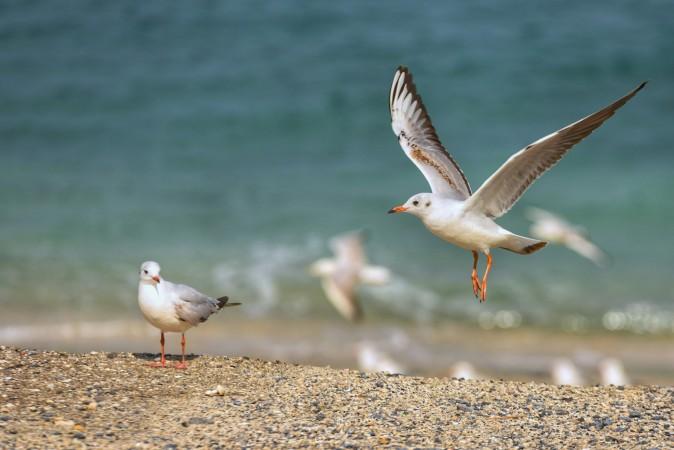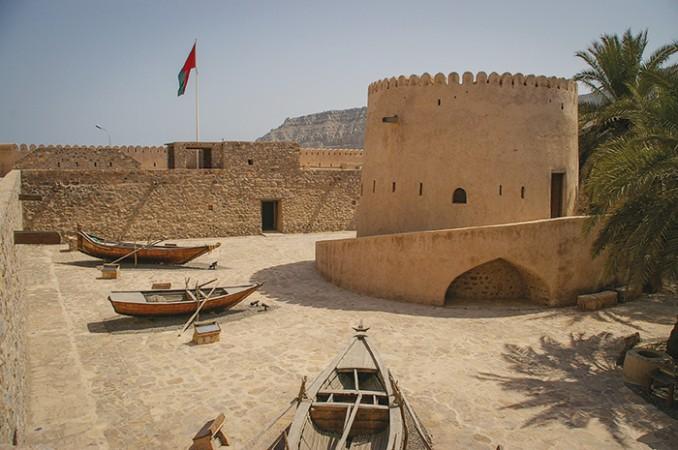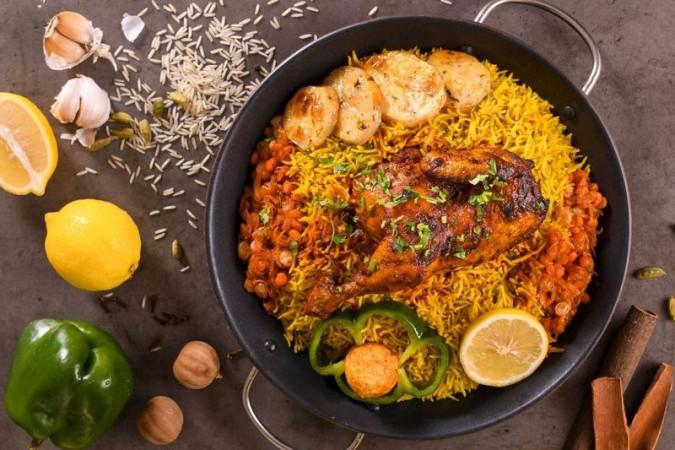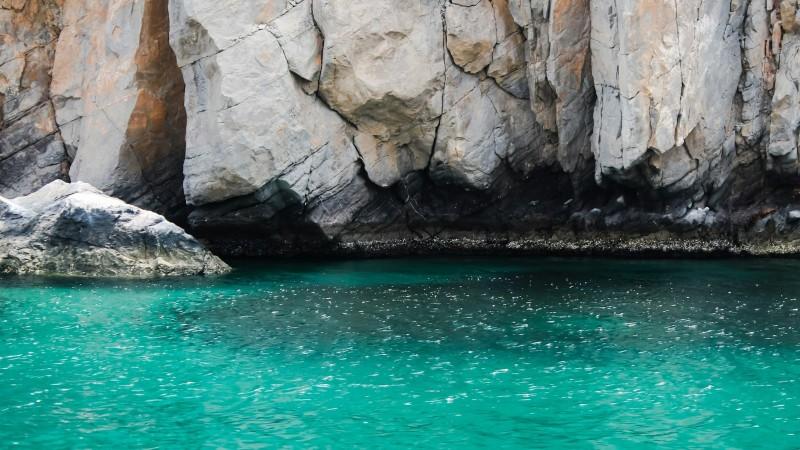Explore Khasab - Oman Travel, Asia
Nestled in the rugged beauty of Oman’s Musandam Peninsula, Khasab offers travelers an unforgettable blend of culture, history, and natural wonders. Known as the "Norway of Arabia" due to its stunning fjord-like inlets, Khasab is a sanctuary for adventurers, nature lovers, and history buffs. With crystal-clear waters, towering cliffs, and warm Omani hospitality, this serene destination is perfect for those seeking both relaxation and exploration. Whether it's cruising through the breathtaking Musandam fjords or diving deep into Khasab’s rich cultural history, there’s something for everyone in this coastal paradise.
Population: Approximately 30,000 in 2020.
Economy: Khasab's economy thrives on fishing, tourism, and small-scale trade, with a growing focus on attracting visitors to its natural beauty and cultural heritage, particularly through eco-tourism and maritime activities.
Landmarks: Famous for the Khasab Castle, Musandam Fjords, and the Jebel Harim.
Oman

Overview of Khasab
History & Cultural Influence
The city has long served as a strategic point along the Strait of Hormuz, an essential maritime route between the Arabian Gulf and the Indian Ocean. This made Khasab a bustling port in ancient times, where traders and explorers around the world exchanged goods and ideas. However, Khasab's culture is profoundly ingrained in Omani traditions and Islamic rituals. The influence of the Bedouin lifestyle, evident in the nomadic tribes that once roamed the mountains and deserts, still permeates the region’s identity today. Visitors can explore ancient villages and witness how traditional ways of life have blended with modernity.
Interaction with the Locals
Khasab, the capital of the Musandam Peninsula in Oman, has a relatively small population with the majority being the Omani and a mix of local tribes. Many residents have careers in fishing, agriculture, and tourism. Known for their warm hospitality, Khasab's residents are proud of their heritage, with strong connections to both the sea and the mountains, and they welcome visitors with open arms, often inviting them to experience their way of life firsthand.

Khasab Castle - © Times of Oman
Top Attractions in Khasab
Khasab Castle
One of Khasab’s most notable landmarks, Khasab Castle, is a symbol of the city’s resilience and strategic importance. Visitors can explore its towers and courtyards, where exhibits of traditional Omani crafts and artifacts offer a fascinating insight into life in ancient Musandam. The castle’s location, surrounded by mountains and overlooking the sea, adds to its majestic charm.
Musandam Fjords
Khasab is famous for its Musandam Fjords, a network of deep, narrow inlets surrounded by dramatic cliffs. Often called the “Norway of Arabia,” these fjords are best explored by dhow cruises, which offer a serene way to view the coastline and spot wildlife like dolphins. The turquoise waters are ideal for snorkeling and diving, revealing vibrant coral reefs and colorful marine life beneath the surface.
Jebel Harim
For adventure seekers, a trip to Jebel Harim (Mountain of Women) is a must. This is the highest peak in Musandam, offering breathtaking panoramic views of the surrounding landscapes. Visitors can take part in off-road safaris that traverse winding mountain paths, passing by ancient petroglyphs and remote villages. The journey to Jebel Harim is as thrilling as the destination, making it a favorite for nature enthusiasts and hikers alike.

Musandam Fjords - © CNN
Must-Try Dishes in Khasab
Omani cuisine in Khasab reflects the region’s deep connection to the sea and its centuries-old traditions. Visitors will find a variety of hearty, flavorful dishes that showcase the unique spices and ingredients of the Arabian Peninsula.
- Shuwa: A traditional Omani dish, Shuwa is made by marinating lamb in a blend of spices and cooking it slowly in an underground sand oven for up to 48 hours, resulting in a tender, flavorful meat that falls off the bone.
- Majboos: Often compared to biryani, Majboos is a spiced rice dish commonly served with chicken, lamb, or fish. The saffron-infused rice is seasoned with a blend of cardamom, cinnamon, and dried lime, giving it a distinct flavor.
- Harees: A popular dish during Ramadan and festivals, Harees is a simple yet delicious porridge made from wheat and meat, cooked to a smooth consistency. It's a comforting dish that showcases Omani culinary traditions.
- Seafood Dishes: Due to its seaside location, Khasab's cuisine is heavily influenced by seafood. From freshly caught grilled kingfish to Samak Mashwi (spiced grilled fish), you’ll find an array of seafood options prepared with regional spices and cooking methods.
- Dates and Omani Coffee (Kahwa): No visit to Khasab is complete without trying Omani dates, often enjoyed with Kahwa, a lightly spiced coffee flavored with cardamom. It’s a traditional offering of hospitality that locals proudly share with guests.

Chicken Majboos - © The Captain Chef
Festivals & Local Celebrations
Khasab is a town deeply connected to its cultural roots, and its festivals are a reflection of Oman’s rich heritage and Islamic traditions. Travelers who visit during local celebrations will experience the region’s warmth, unity, and joy.
Eid al-Fitr & Eid al-Adha
These major Islamic holidays are celebrated with great enthusiasm in Khasab. Eid al-Fitr celebrates the conclusion of Ramadan, the Islamic holy month of fasting, and Eid al-Adha remembers Ibrahim (Abraham)'s willingness to sacrifice his son. During these celebrations, locals gather for prayers, share festive meals with family and friends, and partake in various community events. Visitors are often welcomed to join in these celebrations, experiencing the strong sense of community and tradition.
Oman National Day
Celebrated on November 18th, Oman National Day is a time of patriotic pride throughout the country, including in Khasab. This day honors Sultan Qaboos' birth, who founded modern Oman. Locals celebrate with parades, fireworks, cultural performances, and traditional dances. It's a perfect opportunity for visitors to immerse themselves in the vibrant Omani culture and witness the national pride of the people.

Oman National Day celebration - © Edarabia
What to Do in Khasab
- Dhow Cruises: A dhow cruise through the Musandam Fjords is one of the most popular activities in Khasab. These traditional wooden boats glide along the serene waters, surrounded by towering cliffs. During the cruise, you can spot playful dolphins, explore remote islands, and snorkel in crystal-clear waters.
- Mountain Safaris: For those looking for adventure, an off-road safari to Jebel Harim is an exhilarating way to explore the rugged mountains of Musandam. You’ll travel through winding mountain roads, passing by traditional Omani villages and ancient petroglyphs.
- Snorkeling and Scuba Diving: Khasab’s clear waters and diverse marine life make it a paradise for snorkeling and scuba diving enthusiasts. Popular snorkeling spots include Telegraph Island and the many hidden coves along the fjords.
- Hiking and Trekking: With its dramatic mountain ranges and scenic coastal trails, Khasab is a hiker’s dream. There are several hiking routes that offer varying levels of difficulty, with breathtaking views and the chance to discover isolated villages and historical landmarks along the way.
Shopping in Khasab
- Local Souks: The souks (markets) in Khasab are a treasure trove of traditional Omani goods. You’ll find beautifully crafted silver jewelry, pottery, and woven baskets, all reflecting the region’s rich artisanal heritage. The souks are a great place to practice your bargaining skills while interacting with the friendly local vendors.
- Date and Spice Markets: Oman is known for its delicious dates, and Khasab is no exception. The local date markets offer a variety of these sweet treats, often packaged in decorative boxes that make perfect gifts. Additionally, the spice markets are filled with the scents of exotic spices like saffron, frankincense, and cardamom—essential ingredients in Omani cuisine.

Khasab souk's textile products- © Iwona Castiello d'Antonio
Weather in Khasab: Best Time to Visit
Khasab experiences a typical desert climate with distinct seasons that affect the best time for travel. Knowing when to visit can make your experience more enjoyable, especially if you're planning outdoor activities like hiking, dhow cruises, or sightseeing.
Spring in Khasab
Spring offers warmer temperatures, ranging between 22°C and 35°C (72°F to 95°F), but it's still a good time to visit, especially in early spring. Outdoor activities are still possible, although the rising temperatures may make midday excursions less comfortable. Mornings and evenings remain cool enough for exploring Khasab’s natural beauty.
Summer in Khasab
Summer in Khasab is extremely hot and humid, with temperatures often exceeding 40°C (104°F). Outdoor activities are generally not recommended due to the intense heat. If you’re visiting during this season, it's best to focus on indoor attractions like Khasab Castle or enjoy the cooler early mornings and evenings. Travelers during summer should prioritize staying hydrated and wearing sun protection.
Autumn in Khasab
Autumn represents the transition from summer to cooler months and is a popular season to visit. Temperatures range from 25°C to 35°C (77°F to 95°F), offering more tolerable heat as the region moves into the winter season. This is also an excellent time to experience outdoor activities before the tourist crowds arrive.
Winter in Khasab
This is the peak tourist season in Khasab, with pleasant temperatures ranging from 16°C to 25°C (61°F to 77°F). The weather is cool, making it ideal for outdoor adventures and exploration. This is the best time to enjoy activities like snorkeling in the fjords or taking a scenic mountain safari. Clear skies and mild conditions make winter the most recommended season for visiting.

Experience the natural beauty of Khasab - © Vivek Lad
Essential Travel Information
Getting Around Khasab
- Taxis: Taxis are readily available in Khasab and are a convenient way to travel short distances, such as from the airport to your hotel or to nearby attractions. Be sure to agree on the fare before starting your trip, as taxis may not always use meters.
- Car Rentals: Renting a car is a great option for travelers who want flexibility and independence in exploring the region. Rental cars are available in Khasab, and having your own vehicle allows you to easily visit more remote areas like Jebel Harim or drive along the scenic coastal roads. A 4x4 is recommended for off-road adventures.
- Ferries and Boats: Dhow cruises and ferry services are popular ways to explore Khasab’s Musandam Fjords. These boats can also be used to reach isolated villages and islands that are only accessible by sea. This is a unique way to see Khasab’s natural beauty up close.
ATM & Banking Services
In Khasab, travelers will find convenient access to ATM and banking services, particularly in the town center and tourist areas. Most ATMs accept international debit and credit cards, making it easy to withdraw cash in the local currency, Omani Rials (OMR). While larger establishments, such as hotels and restaurants, often accept card payments, it's recommended to carry cash for smaller purchases, local markets, and taxis, as cash is preferred in many places.
Where to Stay in Khasab
- Luxury Resorts: For travelers seeking a more indulgent stay, Khasab has upscale resorts that offer stunning views of the Musandam coastline, along with premium amenities such as swimming pools, fine dining, and spa services. These resorts provide a relaxing atmosphere with spacious rooms and easy access to major attractions.
- Mid-range Hotels: These accommodations typically offer modern amenities such as air-conditioned rooms, on-site dining, and family-friendly services, all at reasonable rates. These hotels are well-suited for families, groups, or solo travelers who want a comfortable base to explore the area.
- Camping: For the adventurous, camping is an option in Khasab, particularly in the Musandam Fjords or near the mountains. Some tour operators offer guided camping experiences, where you can enjoy sleeping under the stars in one of Oman’s most remote and beautiful locations.
Articles for you

Explore Yala National Park - Sri Lanka Travel, Asia
Tucked away in Sri Lanka’s southeastern corner, Yala National Park is where wild nature meets deep tradition. Known worldwide for its leopard population, the park is also home to elephants, sloth bears, crocodiles, and hundreds of bird species. Beyond wildlife, Yala opens doors to a cultural landscape dotted with ancient temples, Buddhist ruins, and coastal villages. For travelers seeking more than just a safari, Yala offers a chance to explore eco-tourism, local communities, and sacred heritage sites.
Population: The Yala National Park area doesn’t have a human population.
Economy: The economy around Yala National Park thrives on a blend of eco-tourism, agriculture, and local services. Safari tours, eco-lodges, and cultural experiences drive steady income for nearby towns like Tissamaharama and Kataragama, supporting thousands of families.
Landmarks: Famous for Block I of Yala and wildlife encounters, including elephants, sloth bears, crocodiles, and exotic bird species.

Explore Galle - Sri Lanka Travel, Asia
Nestled on Sri Lanka’s southern coastline, Galle is a vibrant city where history meets the sea. Its cobbled streets, colonial architecture, and serene beaches make it a must-visit destination for travelers seeking a blend of culture, adventure, and relaxation. A UNESCO World Heritage site, Galle captivates visitors with its Dutch Fort, bustling markets, and friendly locals. Whether you’re exploring the ramparts at sunset or savoring fresh seafood by the shore, Galle promises an unforgettable journey into Sri Lanka’s heritage.
Population: Approximately 113,000 in 2023.
Economy: Galle’s economy thrives on tourism, trade, and fisheries. The city’s historic fort, colonial architecture, and coastal charm draw thousands of international visitors each year, making tourism its main economic driver. Fishing remains vital for local livelihoods, supplying fresh seafood across the region.
Landmarks: Famous for the Galle Fort, Dutch Reformed Church & Maritime Museum, and Unawatuna Beach.

Explore Bentota - Sri Lanka Travel, Asia
Nestled along Sri Lanka’s southwestern coast, Bentota is a tropical paradise that blends golden beaches, vibrant culture, and thrilling adventures. Famous for its calm waters, luxury resorts, and scenic river estuary, Bentota has become a top destination for travelers seeking both relaxation and authentic experiences. From serene beach walks at sunrise to adrenaline-pumping water sports, this coastal town offers a perfect balance of leisure and exploration. With its proximity to Colombo and Galle, Bentota is easy to reach, making it an ideal stop for both short escapes and extended holidays.
Population: Approximately 37,000 in 2023.
Economy: Bentota’s economy thrives mainly on tourism, which drives local businesses such as hotels, restaurants, and wellness retreats. The town also benefits from fishing, coconut cultivation, and handicrafts like wood carving and batik textiles. Many residents rely on the growing demand for water sports and Ayurvedic treatments, making tourism the backbone of both income and employment in the area.
Landmarks: Famous for Bentota Beach, Bentota River Safari, and Kande Vihara Temple.

Explore Mirissa - Sri Lanka Travel, Asia
Mirissa is a charming coastal town on Sri Lanka’s southern shoreline. Known for its golden beaches, turquoise waters, and vibrant marine life, it has become a must-visit stop for travelers exploring the island. Many come for whale watching, surfing, and sunset views at Coconut Tree Hill, but Mirissa offers much more than postcard beauty. The fishing boats you see anchored by the bay carry generations of stories. Local traditions, delicious cuisine, and a laid-back rhythm of life shape every visitor’s experience.
Population: Approximately 4,700 in 2023.
Economy: Mirissa’s economy is largely shaped by its coastal location. Fishing has long been the backbone of local livelihoods, with generations relying on the Indian Ocean for income. In recent decades, tourism has become the main driver of growth, thanks to whale watching, surfing, and beachside hospitality.
Landmarks: Famous for Mirissa Beach, Coconut Tree Hill, and Parrot Rock Bridge.

Explore Nuwara Eliya - Sri Lanka Travel, Asia
Tucked away in the Central Highlands of Sri Lanka, Nuwara Eliya is often called “Little England”. With its rolling tea plantations, cool misty mornings, and colonial charm, this mountain town feels like a step into another world. Travelers come here to breathe fresh air, walk through flower gardens, sip the finest Ceylon Tea, and enjoy a pace of life far from the island’s busy cities. Whether you’re drawn by scenic landscapes, heritage architecture, or the warmth of its people, Nuwara Eliya is a destination that blends nature, culture, and history in perfect harmony.
Population: Approximately 781,000 in 2023.
Economy: Nuwara Eliya’s economy thrives mainly on tea production, as it sits in the heart of Sri Lanka’s central highlands, famous worldwide for Ceylon Tea. The city also benefits from a growing tourism industry, attracting visitors with its colonial charm, cool climate, and scenic landscapes.
Landmarks: Famous for Gregory Lake, Hakgala Botanical Garden, and Victoria Park.

Explore Sukau - Malaysia Travel, Asia
Nestled on the banks of the Kinabatangan River in Sabah, Malaysian Borneo, Sukau is a destination where wildlife, culture, and conservation come together. Known as one of Asia’s top spots for river safaris and eco-tourism, this quiet village offers a front-row seat to encounters with Bornean orangutans, pygmy elephants, proboscis monkeys, and exotic birdlife.
Population: Approximately 1,400 in 2019.
Economy: Sukau’s economy is shaped by its riverine location and natural resources. Traditionally, the Orang Sungai community relied on fishing, small-scale farming, and forest gathering for their livelihood. Today, the village has shifted toward eco-tourism, with river cruises, jungle trekking, and homestays providing income.
Landmarks: Famous for the Kinabatangan River cruises, Gomantong Caves, and Ox-bow lakes and wetlands.
